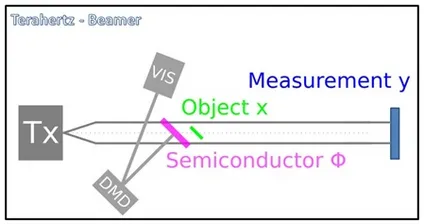CSThz - Compressed Sensing for Terahertz Body Scanners
Project Leader
Xiaoxiang Zhu, Heinz-Wilhelm Hübers
Contact Person
Xiaoxiang Zhu, Johannes Herdegen
Cooperation Partners
German Aerospace Center- Remote Sensing Technology Institute (DLR-IMF)
German Aerospace Center - Institute of Optical Sensor Systems (DLR-OS)
Technical University Berlin (TUB)
Humboldt-Unviersity Berlin (HU)
With our cooperation partners we research novel imaging methods combining software based terahertz imaging (THz), FMCW radar and Compressive Sensing (CS). The objective of the project is to develop CS reconstruction algorithms for THz body scanners in order to improve the image quality of these scanners. Despite significant progress in the past years THz CS is still in its infancy. For example, it has not yet been applied the very relevant topics of THz stand-off imaging security imaging and THz radar imaging. These challenges will be addressed during this collaborative project.
Compressive THz imaging using Spatial Light Modulators (SLM):
Compressive Sensing (CS) suits as a promising technique to make THz imaging feasible, while using only a single THz detector element. We investigate a single-pixel camera (SPC) that relies on non-mechanical scanning with a terahertz (THz) spatial light modulator (SLM) and Compressed Sensing (CS) for image generation. Figure 1 illustrates the CS THz imaging system developed within the project collaboration. Peculiarities of the THz spectral region require tackling several challenges within the CS framework. Such as multi-path propagation, diffraction problems, speckle and coherence effects of the radiation. In the project we are working on optimizing the CS approach in the THz region, while accounting for these effects within the reconstruction algorithms.


3D FMCW THz radar imaging system:
Within the project a FMCW THz radar imaging system is developed, that combines THz imaging in x,y and FMCW radar in the z direction to produce 3D images. Our project part focuses in particular on developing and improving reconstruction techniques for this specific application in order to increase the image quality and the image acquisition speed. On the one hand we are investigating the effect of different blurring kernels and sensing matrices (masks), while modeling the imaging system. On the other hand we are developing a sophisticated joint 3D reconstruction algorithm, by using regularizers from image processing and computer vision, as well as prior knowledge of the objects sparsity. Our reconstruction techniques are tested and optimized on practical data provided from the FMCW THz radar imaging system in the project collaboration.